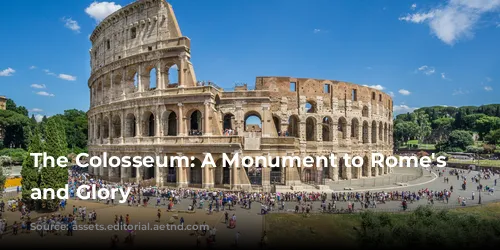The Colosseum, a colossal stone amphitheater, stands as a testament to the grandeur of the Roman Empire. Its history is deeply intertwined with the rise and fall of emperors, the changing tides of Roman society, and the enduring fascination with gladiatorial combats and other spectacles.
A Gift to the Roman People
Emperor Vespasian, a pragmatic ruler who emerged from the chaos following the death of Nero, sought to restore stability and appease the Roman populace. He envisioned a grand project that would demonstrate his commitment to the people: a magnificent amphitheater to host gladiatorial contests, animal hunts, and other forms of entertainment. This ambitious project was intended to be a gift to the Roman people and a symbol of their power.
A Symbol of Power and Entertainment
Vespasian chose a site that was both symbolic and practical: the land where Nero had built his extravagant Golden Palace, which was torn down after the emperor’s demise. The location, near the Roman Forum, was a central hub of Roman life, making the Colosseum a focal point for the city.
Construction began around 70-72 AD, and after a relatively short time, Titus, Vespasian’s son, inaugurated the Colosseum with a spectacular 100-day festival in 80 AD. The Flavian Amphitheater, as it was officially known, was a marvel of engineering, showcasing the Romans’ exceptional skill in architecture and construction.
The Majesty of the Colosseum
The Colosseum was a colossal structure, measuring an impressive 620 by 513 feet, making it the largest amphitheater in the Roman world. Unlike other amphitheaters built into hillsides, the Colosseum was a freestanding structure, a testament to the Romans’ innovative building techniques.
The exterior was a stunning display of architectural design. Three tiers of arched entrances—around 80 in total—were supported by sturdy columns, each tier showcasing a different order: Doric, Ionic, and Corinthian, progressively more ornate. The Arch of Constantine, erected in 315 AD, stood near the main entrance, further emphasizing the grandeur of the site.
A Stage for Spectacles
The Colosseum held more than 50,000 spectators, who were likely arranged by social rank. They witnessed a dazzling array of events: gladiatorial combats, animal hunts, mock naval battles, and other spectacular performances. Awnings provided shade from the scorching Roman sun, ensuring the comfort of the audience as they watched the thrilling performances.
While the majority of the combatants were men, some female gladiators graced the arena. The gladiators were typically slaves, condemned criminals, or prisoners of war, their lives often a brutal and violent affair.
The Colosseum Through Time
For four centuries, the Colosseum was a center of entertainment, a stage for the gladiatorial spectacles that captivated the Roman public. However, the decline of the Western Roman Empire and the changing tastes of the population led to the gradual decline of gladiatorial combats.
Over the centuries, the Colosseum fell into disrepair, plundered for building materials, and subjected to the ravages of nature. Its marble seats and decorative elements were stripped, and the majestic structure was reduced to a shadow of its former glory.
Revival and Preservation
The Colosseum eventually found a new purpose as a source of inspiration and a reminder of Rome’s rich history. Restoration efforts began in the 1990s, aiming to revive this iconic monument. Today, the Colosseum remains a major tourist destination, captivating visitors with its grandeur and offering a glimpse into the vibrant life of Ancient Rome. Its story serves as a reminder of the power and glory of the Roman Empire, its tumultuous history, and its enduring legacy.


